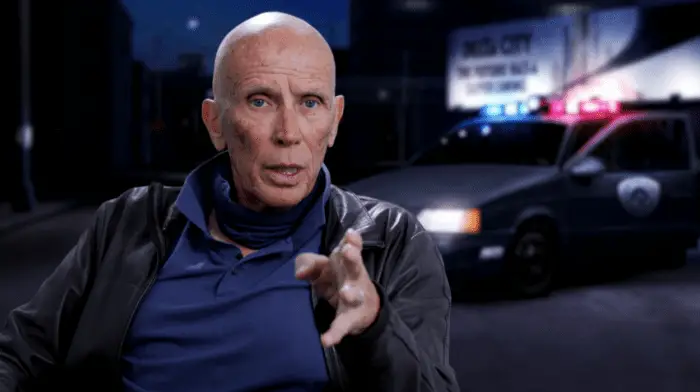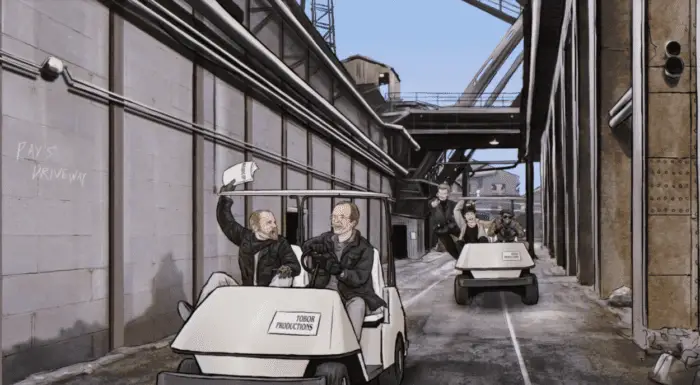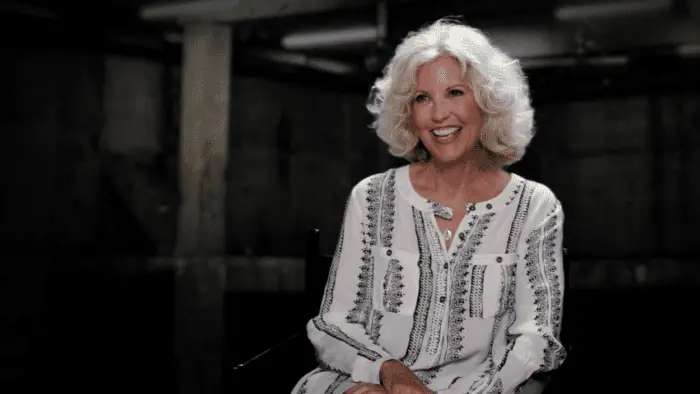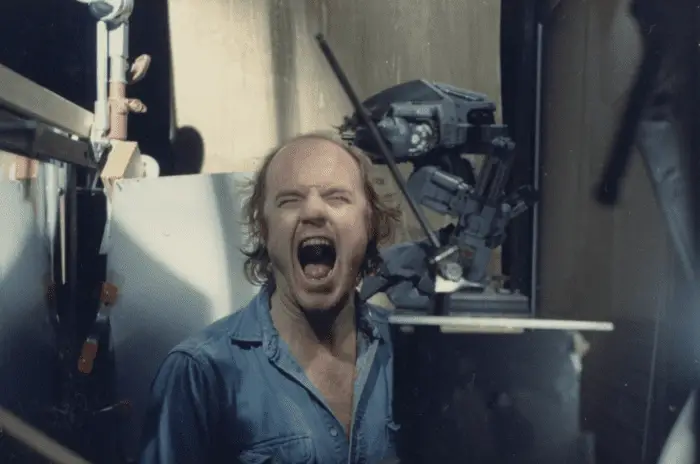Robodoc: The Creation of Robocop is a joyful documentary exploring the film Robocop. The 1987 sci-fi action classic is retrospectively revisited with a fine toothcomb. Over sixty interviews, miles of archival footage, and abundant trivia combine into something that will satisfy the most hardcore fan, but this film is more than a mere love letter to a pop culture icon. It’s also an interesting look at how a motion picture can come together.
Written and directed by Christopher Griffiths and Eastwood Allen, Robodoc is a comprehensive reflection on an award-winning film. Although devoted fans, as a special feature charmingly reveals, the two manage a certain objectivity. They’ve not only collected a vast amount of material but had the wherewithal to leave in some slightly sour notes. The portrait is not always flattering as cast and crew recall difficulties during a tumultuous production. However, Robodoc succeeds by permitting the ugly details. After all, the truth can’t help admitting to faults.

It doesn’t hurt that decades have gone by allowing any animosity to cool. The film crew can now recount with a chuckle battling the manic volcanic director, Paul Verhoeven. Whatever grudges may or may not have existed in the past are now fodder for amusing anecdotes. The occasional divo behavior of star Peter Weller inspires a smirk and a shrug rather than fists of rage. But the warts are there making Robodoc nothing close to a fawning account.
The realities of a difficult film shoot come across through a series of interviews with everyone conceivably involved. Besides the main cast such as Kurtwood Smith, Ronny Cox, and Nancy Allen, there are recollections from many supporting performers. No role is ignored. Folks who only appear in a single scene are given a chance to remember their appearance. One person even relates details of a moment that was ultimately cut from the movie. In addition, it seems like every member of the crew alive and willing answered one or two questions.
The result is a wide-ranging oral history encapsulating the production from start to finish. Robodoc captures everything from acting concerns about how to portray a cyborg to the intricacies of shaping the film’s Academy award-winning soundscape. It shows that despite contentions filmmaking must be a collaborative process to succeed. Plus, there’s also revelations of how seriously everyone involved took a concept that others found ridiculous. And it’s easy to see how that seriousness shaped a clever action-packed satire into a long-lasting legend.

Although there are tales of contention, there are also wonderful memories being shared. The camaraderie between the performers who played Clarence Boddicker’s gang, the thrill of figuring out some elusive special effect, and the joy of realizing something special was being made are all part of Robodoc: The Creation of Robocop. The documentary really shows the people involved as well as giving them the time to share their part in what would become an iconic part of pop culture.
Unfortunately, some, like the late Miguel Ferrer are unable to add their piece. However, archival footage abounds throughout Robodoc. As such, no voices are lost. While this allows ghosts of the past, it also means trivia tidbits and easter eggs which will satisfy fans.
Make no mistake, this is a loving look back at a film which has enthralled many. They are the audience most likely to watch Robodoc and will definitely not be disappointed. Yet, the movie may be interesting for those who aren’t the most ardent Robocop enthusiasts. Throughout the documentary are frank tales of how difficult a film can be to make. Old familiar Hollywood woes surface such as dealing with money problems. Intriguingly, Robodoc contains numerous accounts of clever solutions. The way the Robocop filmmakers got around a tightening of the purse strings, I won’t spoil here, but it is brilliant.

These lend Robodoc: The Creation of Robocop a level above fan service. The documentary becomes an inside glimpse into making movies. That said, the lessons one garners while watching are up to the audience. Some may be inspired to mimic the frenetic, borderline abusive behavior of director Paul Verhoeven, since the stress he induced seems to have helped the film. Others may feel it’s better to take another route. What’s important, though, is that Robodoc unflinching delivers the ups and downs.
This isn’t a romanticization of filmmaking. Performers recall frustrations, getting hurt physically and emotionally, while the crew admits to frayed nerves crackling like fusewire burning towards dynamite. Yet, the result is a well-earned pride clearly expressed by interviewees. Still, no one comes across like they’re trying to sell a legacy. They just want to share their history with this film.
Historically, Robodoc captures a kind of filmmaking that doesn’t exist much anymore. There’s nothing digital, no CGI; everything is a composite, optical, or physical effect. In essence, everything is real.

Archival footage helps relate this as do scraps of production notes. Plenty of behind-the-scenes recordings recount things like making the recognizable Auto 9 pistol. Yet, somehow, nothing magical is ever lost. The presentation maintains the impression of something special coming to life.
At nearly five hours in length, Robodoc is a time commitment. Fortunately, animated sequences, excellent editing, and some truly clever exhibitions keep the viewing smooth. For instance, interviews are spliced into television screens within Robocop emphasizing a performer’s connection to a scene. There are occasional cuts which make it seem like characters from the iconic film are reacting to something said. It all adds up to a documentary that flows evenly at a reasonable pace from start to finish. There’s time enough to tell the tale without anything getting lost in the mix.
The great thing about a documentary like Robodoc: The Creation of Robocop is it reminds audiences how unique a piece of cinema once was. After so many years of being iconic, it’s easy to forget a time when, in this instance, that film wasn’t an instantly recognizable pop culture reference. Robodoc is a refreshing reminder of how legends are born.


